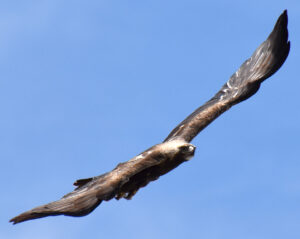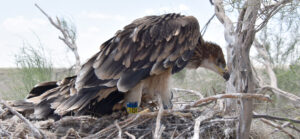Third International Scientific and Practical Conference “Eagles of the Palearctic: Study and Conservation”
Raptors Conservation. Suppl. 2. Proceedings of Conferences
The Imperial Eagle in the south-east of Kazakhstan 2022–2023: distribution, population numbers, threats
Kaptyonkina A.G. (Biodiversity Research and Conservation Center Community Trust, Astana; Institute of Zoology of the Ministry of Education and Science of the Republic of Kazakhstan, Almaty, Kazakhstan)
Pulikova G.I. (Biodiversity Research and Conservation Center Community Trust, Astana, Kazakhstan)
Sagaliev N.A. (Biodiversity Research and Conservation Center Community Trust; Republican state institution “State National Natural Park ‘Buiratau’”, Astana, Kazakhstan)
Karyakin I.V. (Russian Raptor Research and Conservation Network; Sibecocenter LLC, Novosibirsk, Russia)
Contact:
Alyona Kaptyonkina alyonakaptyonkina@gmail.com
Genriyetta Pulikova genriyetta.pulikova@gmail.com
Nurum Sagaliev sagaliyevnurum76@gmail.com
Igor Karyakin ikar_research@mail.ru
Recommended citation: Kaptyonkina A.G., Pulikova G.I., Sagaliev N.A., Karyakin I.V. The Imperial Eagle in the south-east of Kazakhstan 2022–2023: distribution, population numbers, threats. – Raptors Conservation. 2023. S2: 329–334. DOI: 10.19074/1814-8654-2023-2-329-34 URL: http://rrrcn.ru/en/archives/35121
Imperial eagle (Aquila heliaca) is one of the rare species of eagles breeding in Kazakhstan and inhabiting almost the entire territory of the country. The south and south-east of Kazakhstan is the southeastern border of the breeding range of the species (Karyakin, 2020). It is this part of the range that will be considered in this paper. The Imperial Eagle is classified as a Vulnerable species by the IUCN (BirdLife International, 2019), and in Kazakhstan it is listed in the Red Data Book as a Rare and Declining Species (Category III) (Pfeffer, 2010).
The global population of imperial eagles as of 2016 was estimated at 2.5–9,900 adults (BirdLife International, 2019), but the current estimate of the global population is 8099–9981 breeding pairs, whereof Kazakhstan has 3420–4260 breeding pairs or 42.2–42.7% of the global population (Karyakin, 2020).
20 pairs recorded here (Karyakin, Barabashin, 2006; Karyakin et al., 2008; Gubin, 2018). B.M. Gubin (2018), summarizing his data on Western Betpak-Dala, reports 60 known inhabited nests of Imperial Eagles, 39 of which were located on the poles of high-voltage power lines and 21 on saxaul; the birds nested most densely between Taikonur and the water station that supplies water to Stepnoi settlement.
By 2018, a minimum of 18 breeding territories of the Imperial Eagle were recorded in the Chu Valley and the area from Shuto Taikonyr (Karyakin, Barabashin, 2006a; Karyakin et al., 2008; Gubin, 2018; Abdullin et al., 2020; Andreenkov et al., 2020). A large group of the species is still present in southern Kazakhstan. In the last two years, research has been conducted and the population size of the Imperial Eagle has been revised along the edge of the Moiynkum sands in forest belts, where eagles of this species have not been monitored before. A large breeding group of more than 100 pairs is concentrated in the Moiynkum sands, which forms the southeastern edge of the desert population of this species (Karyakin, 2020). During two research seasons (2022 and 2023) it was possible to collect characteristics of 49 nest structures of the Imperial Eagle. Most nests (85.71%) were found on the Chinese Elm (Ulmus parvifolia), 6.12% on Turanga (Populus sp.), 4.08% on saxaul (Halóxylon sp.) and one nest each or 2.04% were recorded on Elaeagnus (Elaeagnus sp.) and electric poles (n=49). In 2022, clutch sizes ranged from 1 to 3 eggs, averaging 2±0.63 eggs per successful nest. The obtained data correlate with generalized data from literature sources.
The research in 2022 (in 2023, research was conducted only in spring) showed satisfactory breeding success of the Imperial Eagle in the area under examination – 40% of successful nests, by the end of the season brood size ranged from 1 to 2 fledglings, averaging 1.75±0.5 fledglings per successful nest (n=4) and 0.78±0.97 fledglings per active nest (n=9). The overall breeding success for all nests examined was 44.44% and breeding efficiency was 58.33% (Karyakin et al., 2023). Despite the depression of the rodent population, imperial eagles are quite efficient in reorganizing to feed on different bird species and use other food items among mammals (hares Lepus sp., hedgehogs Erinaceus sp., etc.).
The Imperial Eagle does not breed in the Talas Alatau (Kovshar, 1966, 2019), but is observed on migration (Chalikova, 2004; 2009; Kolbintsev, 2007; Karyakin et al., 2021). Moving eastward, to the Pribalkhashie, we can notice that the density of the species decreases. Modern finds of Imperial Eagle nests in the Southern Pribalkhashie indicate that the Imperial Eagle remains a characteristic breeding species here, but does not form dense breeding groups (Karyakin, 2020). In the east of Balkhash and on the plain to the west and south-west of Lake Alakol, the Imperial Eagle becomes rarer on breeding grounds.
The results of the 2023 research in the south-east of the country indicate the absence of imperial eagles in the northern foothills of the Dzungarian Alatau and in the southern foothills of Tarbagatai. Only one case of breeding of a "mixed pair", a female Imperial Eagle and a male Steppe Eagle (Aquila nipalensis), was recorded. Unfortunately, breeding was not successful. On the foothills plain, only single pairs of imperial eagles penetrating from the sands of the Southern Pribalkhashie nest in trees in artificial forest plantations and on power towers, distancing themselves usually more than 7 km from the other pair.
In the XXI century, adult imperial eagles have not been observed anywhere else in the foothills of the Ketmen, Kungey Alatau and Zailiyskiy Alatu Mountains during the breeding season and their nests have not been found. As of 2018, the number of imperial eagles in Almaty Region was estimated at 20–40 pairs, and in Zhambyl and Turkestan Regions at 90–140 pairs (Karyakin, 2018). Given the number of known breeding territories, taking into account the literature and data from the datasets, it can be assumed that the population estimate is grossly understated for the Almaty Region, and the lower limit of the population estimate is understated for the Zhambyl and Turkestan Regions (Karyakin, 2020).
There are a number of threats that affect the viability of imperial eagles in Kazakhstan. The main threat to the southeastern population of this species is the lack of food base. For several years now, there has been a depression in rodent population in southern and southeastern Kazakhstan, affecting all species from the Great Gerbil (Rhombomys opimus) and the Yellow Ground Squirrel (Spermophilus fulvus) to voles (Microtus socialis and Alticola argentatus) (Karyakin et al., 2022). Zoologists and locals have observed rodent depression since 2017. Another threat may be the degradation of imperial eagle habitats associated with both climatic and anthropogenic changes. For many years and even decades, the threat of dying of birds on power lines has persisted. This threat is particularly immediate because a significant proportion of imperial eagles nests on electric poles, where tree plantations are scarce, mainly along roads. In addition to the fact that birds die from collision with electric poles, from electrocution, there is a problem of nests being thrown off electric poles by employees of power companies during repair works or scheduled maintenance of power lines.
Despite the many negatives affecting the Imperial Eagle, the situation with the Imperial Eagle is much better than with the Steppe Eagle, which has almost completely disappeared in the mountainous and foothill areas of Southeast Kazakhstan and has significantly reduced its numbers in the plains. The solution of the problem of bird deaths on power lines and the dropping of eagle nests from power lines would contribute to a greater survival rate of the Imperial Eagle and help it to survive the global depression of rodent numbers in Southeast Kazakhstan with fewer losses.


